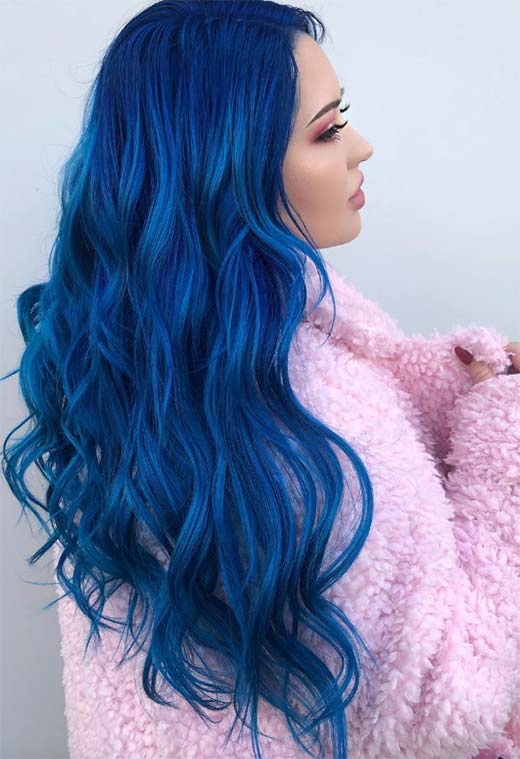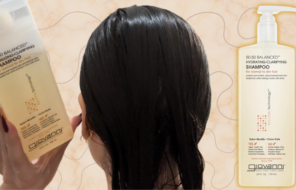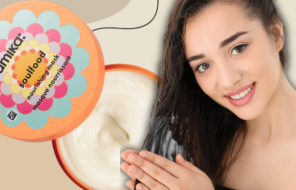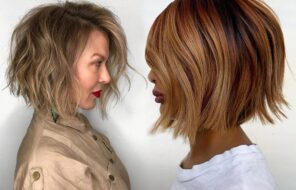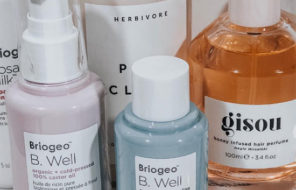We’re massive fans of silvery blue hair dye for winter, while in spring and summer, we favor more saturated variations like cobalt and violet blue. These days, blue hair dye can also be incorporated into modern hair coloring techniques like babylights, sombres, and balayage. If you are also starting to think that blue hair will keep away the blues, then it’s time to make a change.
If you’re considering dyeing your hair blue, we’re here to help with the most comprehensive guide to rocking blue hair dye! We’ll cover everything you need to know about blue hair from beginning to end: we’ll help you pick the best shade of blue hair for you based on your skin tone, we’ll teach you everything you need to know about dyeing your hair blue at home, and we’ll also give you all the tips and trick to maintaining your blue hair’s vividness for as long as possible.
To keep you feeling stylish with your new hair, we’ve also added some makeup and fashion tips, because intense colors need to me complemented and matched! Should you change your mind about the whole blue hair thing, we’ve also added instructions on how to remove blue hair dye from your locks at home.
In this article:
- How to Pick the Best Blue Hair Color for Your Skin Tone
- How to Dye Hair Blue at Home
- Tips for Maintaining Your Blue Hair Dye
- How to Remove Blue Hair Dye?
- Makeup Tips for Blue Hair
- Fashion and Style Tips for Blue Hair
How to Pick the Best Blue Hair Color for Your Skin Tone
When you’re considering taking the plunge into fashion hair, it is important to take your skin tone into account. Just about anyone can rock blue hair color, but that doesn’t mean that every shade of blue will work. Your skin’s undertone and to a lesser extent its darkness should both be taken into account when choosing the particular shade of blue hair dye you’ll want to use.
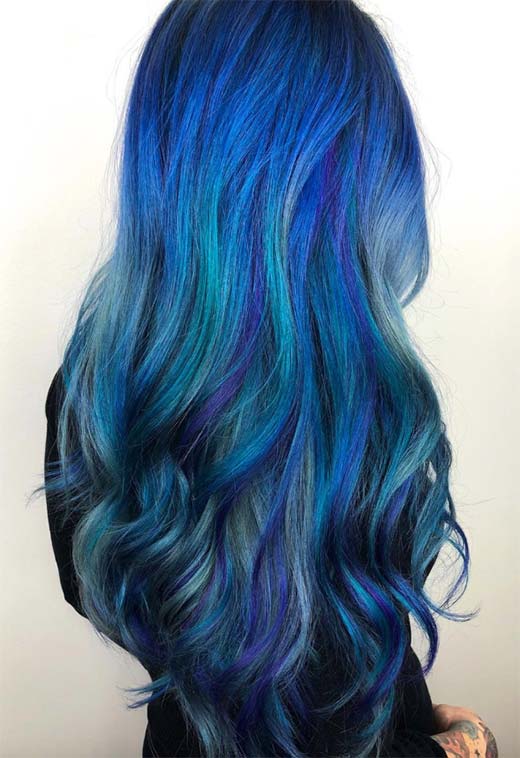
I’ll start off with the easier part: how to pick the right shade of blue to go with your skin based on how light or dark it is. There isn’t a specific rule here, but you do want to keep the following in mind: your hair and skin shouldn’t compete for attention.
- This means that if your skin is extremely fair, you probably don’t want your hair to be a very light pastel blue, because then you run the risk of your hair washing you out. Blue hair that is a touch darker and going all the way up to blue black will look awesome, on the other hand! Think bright azure or cerulean blue hair colors!
- If your skin is medium toned, then both pastel blues and dark blues will look incredible, while medium blues will only work well if they are well saturated.
- Lastly, those with very dark skin might want to brighten things up with a dramatic baby blue or they might want to channel their inner anime character with a royal blue. However, a navy blue hair dye might be underwhelming against their skin.
Blue Hair for Every Undertone
- If your skin has cool, pink undertones with a lot of redness and veins that appear purple-ish, then you will definitely want to stay away from electric or green-leaning blues that will emphasize redness in your skin. Instead, opt for true blues and violet-leaning blues, which will work harmoniously with your skin to make it look more even toned.
- Those with warm skin that has golden or yellow undertones, with veins that look a little greenish through the skin, can opt for both green and purple-leaning takes on blue hair dye, which will be quite flattering, while true royal blue runs the risk of emphasizing yellowish sallowness in the skin.
- Next there are those with olive undertones in their skin, which means their skin has a slight green tint to it, which can be either cool or warm. People with olive skin should avoid purple-leaning blue hair colors, as that slight redness will emphasize the green tones in a sickly way. Instead, they should embrace true blue hair tones as well as green-leaning blues like teal and turquoise, which will complement the skin beautifully.
- Lastly, there are the lucky few with beige undertones to their skin, which lean towards neither pink nor yellow. Those with beige undertones can enjoy the full color spectrum, playing with true blues, green blues, violet blues, and anything in between (as well as the various combinations of shades!).
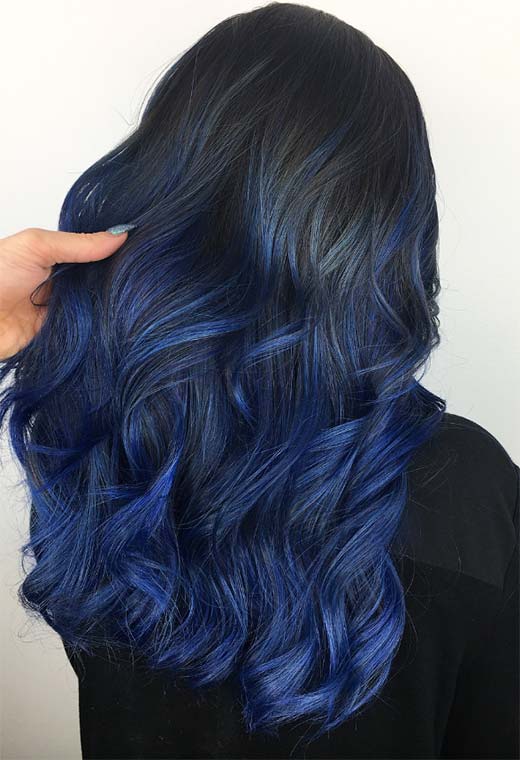
How to Dye Hair Blue at Home
As with many other fashion hair colors, the blue hair dye available on the market is almost exclusively semi-permanent. While this kind of dye may be applied to virgin hair, it will only tint it a bit. Unless your hair is naturally extremely light, most blue hair looks will require that you bleach your hair first, especially if you want your hair to be pastel or electric blue.
If you have naturally dark hair and you would like a blue tint, you can skip the bleaching process altogether. Unlike with permanent hair colors, it is perfectly safe and even healthy to dye the hair on the same day that you’ve bleached it, but if you need to do multiple bleaching sessions to reach your desired lightness level it is better to stretch them out over the course of multiple days.
You will need:
- Hair bleach – Our favorite is the Manic Panic Flash Lighting 40 Volume Complete Maximum Hair Lightening Kit from Ulta Beauty.
- Blue hair dye – you can use just one color, or mix a blue hair dye with a bit of green or purple to get a particular tint. We recommend: Good Dye Young Semi-Permanent Hair Color from Sephora, Punky Semi-Permanent Color from Ulta Beauty, and Joico Color Butter also from Ulta Beauty.
- Mixing bowl
- Hair dyeing brush
- Latex or plastic gloves
- Sacrificial button-up shirt that might get dirty
- Butterfly hair clips
- Shower cap or plastic bag
- Washcloth
- Petroleum jelly
- Blue toned shampoo like the Joico Color Balance Blue Shampoo from Ulta Beauty.
- Hair conditioner or conditioning mask

Step 1: Prep
- Make sure to avoid washing your hair for a few days before you intend to dye it, especially if you will also be bleaching it first.
- Get your hair in the best condition possible by giving it a nourishing protein mask the day before you’ll be bleaching it.
- Make sure you have all of the tools you’ll need to dye your hair blue.
- Make sure you have selected the exact blend of blue hair dyes that will allow you to achieve the exact shade of blue you want for your hair.
- Get your action plan in order! I’ll give instructions here for dyeing your hair in a solid, all-over color, but you might only want to dye the ends or a few streaks. You might also be considering bleaching only a few parts of your hair, so that when you dye your hair blue it will be lighter in some places and darker in others. Give it some thought before starting!
Step 2: Bleach
- Before you start, put on gloves to protect your hands and pull on an old button-up shirt that you’re not concerned with staining.
- Make sure to reach the instructions on the bleaching kit you’ve picked up, since instructions vary very widely from kit to kit. These instructions are meant to go with the Manic Panic bleaching kit we recommend.
- Start by preparing your bleach. In the kit we recommend there will be a powder and a developer, which you should pour into a mixing bowl and then use your hair dye brush to mix together until you have a smooth mixture without any lumps. Allow the bleach to settle for about a minute or so.
- While the bleach develops, clip your hair up into sections. We usually recommend parting the hair from ear to ear along the crown and again in the center, so you have four even sections, although if your hair is very fine you can do just a front and back section, while if it is very thick you can part it into five or six sections instead.
- Starting with one of the front sections of the hair, undo the clip and begin applying the bleach. Apply the bleach to the hair in even smaller subsections that are a couple of centimeters in width. We don’t recommend getting too close to the roots or the scalp, so instead start by applying the bleach a centimeter away from the hair. With your brush, pull the bleach down all the way to the ends.
- Make sure the bleach totally saturates the hair and covers every side of ever strand by rubbing it in a bit with your gloved fingers.
- Continue the dyeing process until you’ve finished covering the whole section of hair in bleach, and then clip it up. Next you can move on to the next section of hair.
- Once you’ve covered your whole head in bleach and clipped up all hair sections, cover your head in shower cap, and allow hair to process.
- After about ten minutes remove the shower cap, and using a damp washcloth remove a bit of bleach from a bit of hair. If you are satisfied with how light your hair looks, you can remove the cap and hop into the shower to rinse out the bleach. If not, recover that chunk of hair in bleach, and wait another 10 minutes to check again.
- Once it’s time, hop in the shower and rinse away the bleach with cool or lukewarm water. Shampoo your hair with a toning shampoo to ensure all the bleach is gone and that the hair won’t look orange or brassy.
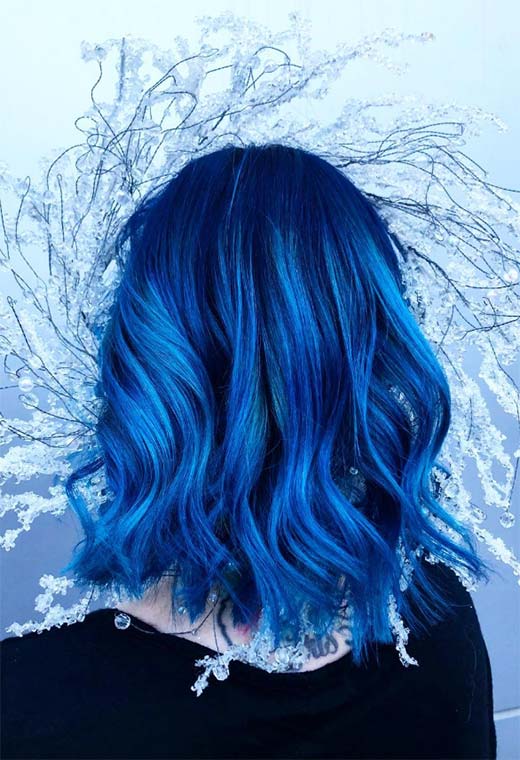
Step 3: Dye
- There is no need to wait! Semi-permanent hair dyes can normally be applied to damp hair, so if you’ve just washed out the bleach, then simply towel-dry your hair gently. If you are just opting for a blue hair tint, then you can start with dry hair.
- Before you actually start, however, put on your gloves, a shirt that can get dirty, and make sure to line the perimeter of your hair with petroleum jelly to prevent your skin from staining.
- If you’re aiming for pastel blue hair rather than a darker or more vivid blue, then prepare a weakened mixture of dye by combining one part of the blue hair dye or dyes of your choice with 3 parts of hair conditioner in a mixing bowl.
- Section and clip up your hair much the same way you did previously for bleaching it – 3, 4, 5, or however many sections you think are necessary for your hair.
- Undo the first clip, and from that section separate out a smaller section of hair. Dip your hair dyeing brush into your blue hair color, and begin applying the color to that small subsection of hair, starting as close to the scalp as possible.
- With the brush, pull the color down towards the ends, and reload the brush with dye if necessary in order to cover the whole chunk of hair.
- Using your gloved hand, massage the blue hair color into the chunk of hair a little bit, to ensure that the hair is thoroughly covered.
- Repeat this process with the next subsection of hair. Once you’ve covered the whole section of hair in blue hair dye, clip it back up and move over to the next section, once again dyeing the hair in smaller subsections.
- Once your whole head is covered in blue hair dye, give it time to process. Normally 10-15 minutes is enough time for bleached hair, while unbleached hair will take at least half an hour to change color.
- In order to avoid making a mess, cover your head in a shower cap – otherwise the blue hair dye might stain anything it comes in contact with!
- Once enough time has elapsed, hop into the shower, and rinse out the blue hair dye with lukewarm water. Avoid shampooing your hair, but you can absolutely take the chance to condition it.
- Get out of the shower and gently towel-dry your hair. You can use a cotton T-shirt instead if you’re worried about damaging your hair.
- Examine your hair to make sure it has been dyed to your satisfaction. If you think you’ve made any errors, then go back in with a bit more blue hair dye to correct any mistakes. If you’re happy with it, then go take some photos and show the world your new hair color!
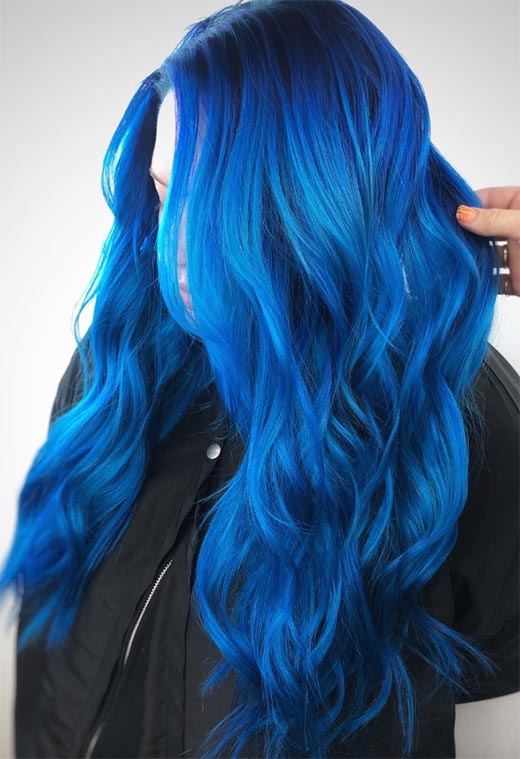
Tips for Maintaining Your Blue Hair Dye
Blue hair dye is one of the quickest fading hair dyes around, so it will require some care and maintenance to keep it looking fresh and vivid.
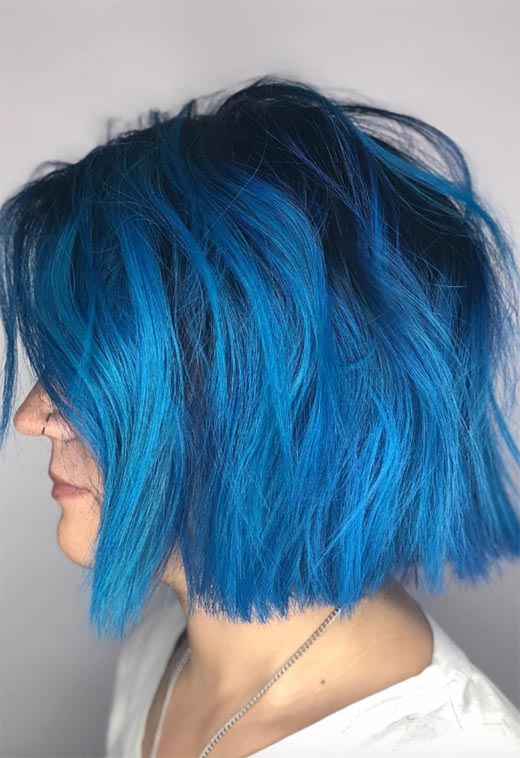
- Avoid shampooing your hair for the first few days after you’ve dyed it, as the shampoo will remove a lot of the blue hair dye that you’ve worked so hard to apply.
- In general, you will want to reduce the frequency at which you wash your hair, as each time you shampoo your hair some blue hair dye will inevitably be removed.
- When you do shampoo your hair, make sure you use a shampoo that is sulfate-free. Sulfates like SLS and SLES can seriously strip the hair of dye, as well as the oils that keep your hair healthy. If you can get away with it, co-washing with just hair conditioner might be the healthiest thing for your hair.
- When showering, make sure to use cool or lukewarm water, as hot water will open up the cuticles of your hair and cause the blue hair dye to bleed out of it. It will also keep your hair in healthier shape in general.
- You can easily refresh your hair at home, as well. Mix up your own color refreshing treatment by combining three-parts hair conditioner or conditioning mask with 1-part blue hair dye, and apply it to your hair the way you normally would a conditioning mask. Let it sit for 5-10 minutes, and then rinse away and your color will be back to its former vividness. You can do this once a week.
- Keeping the roots a dark blue is another way of keeping your blue hair healthier and making maintenance easier. You won’t have to run to the salon to bleach and dye your roots the second they start peeking out – instead, you can just give ‘em a wash of blue so they blend into the rest of your hair without clashing. Sombre and balayage hairstyles are a particularly chic way of doing this, as the darker blue roots will give a lot of depth to the rest of your hair.
- Especially if your hair has also been bleached, make sure to avoid extreme heat styling. You can blow-dry your hair gently every once in a while, but stay away from straightening and curling irons, as the intense heat will damage your hair.
- Regularly masking your hair with protein-rich hair masks will do wonders, as after bleaching the amount of proteins in the hair gets depleted, which leaves the strands weaker and more brittle.
- Make the switch from towel-drying your hair to using an old cotton T-shirt instead. The rough bristles of the towel can damage the hair cuticles and lead to color bleeding out, while a T-shirt will be much gentler on both your hair and color.
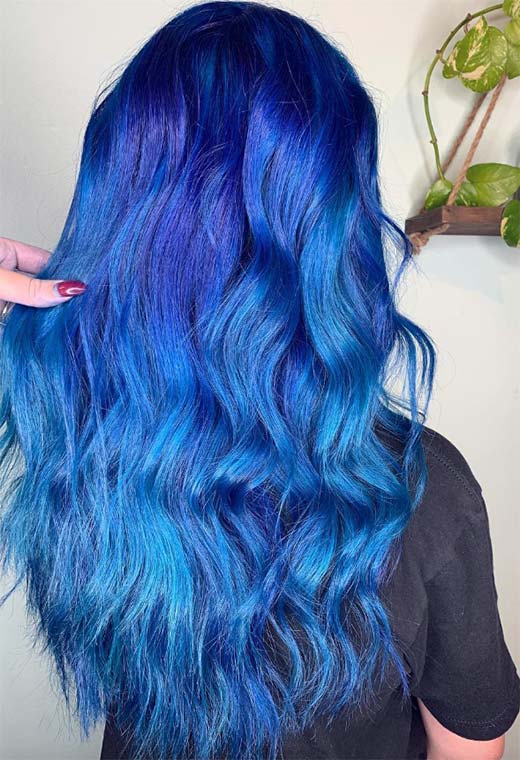
How to Remove Blue Hair Dye?
If you are sick and tired of your blue hair color and want to change it, there are a couple of ways you can do this at home.
Clarifying Shampoo
- Start by washing your blue hair with a clarifying shampoo and warm water. This is the only time I will ever recommend a shampoo that contains sulfates, since they are the best for removing hair dye from the hair. Since most blue hair dyes are semi-permanent, washing once with a clarifying shampoo might lift enough color so that you can dye your hair again.
- Some people find dandruff shampoo works just as well as clarifying shampoo, while others prefer dishwashing detergent!
- Make sure to condition your hair after using the clarifying shampoo, as clarifying shampoos strip a lot of oils from the hair in addition to stripping colors.
Vitamin C Method
- If simply using clarifying shampoo wasn’t enough to remove the blue hair tint from your hair, then you will have to resort to a more intense method – the vitamin C method.
- In a plastic bowl mix together clarifying shampoo with vitamin C powder or crushed up vitamin C tablets. The mixture should be about equal parts vitamin C and shampoo, and it should have a thick, runny consistency. Apply the vitamin C mixture to your hair while it is dry, and then add just a bit of water in order to make it spread more evenly and foam up a little.
- Put your hair up into a bun and cover it with a shower cap. Let the mixture sit in your hair for at least half an hour, and then rinse it out with hot water.
- You can repeat this method a few times until you feel like enough of the blue hair dye has been lifted from your hair.
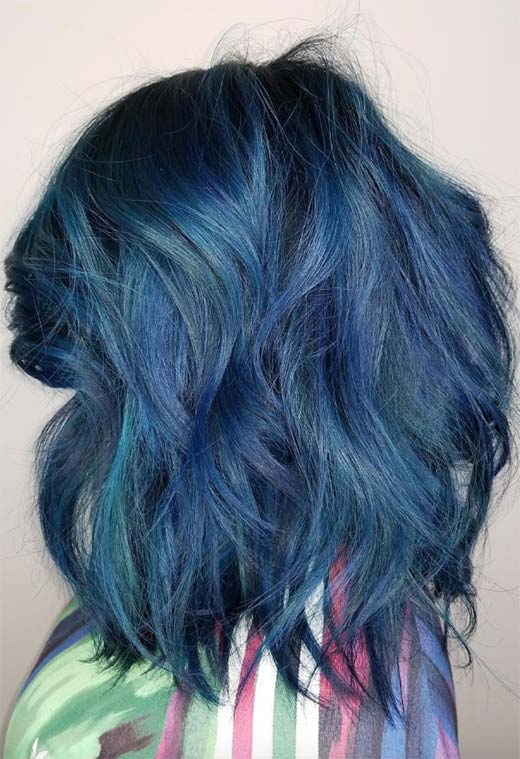
Bleaching the Hair
- If you’ve tried the first two methods of removing blue hair dye and you still feel like not enough of the dye has been removed, then it’s time to break out the big guns – i.e. bleaching your hair again.
- It’s better to use a weaker bleach if you’re going to be working on already bleached hair. Something with a 20- or 30-volume developer will be gentler than an intense 40-volume developer.
- You can bleach your hair following the same method I outlined earlier when explaining how to bleach your hair before dyeing it blue!
Dyeing the Hair
- So technically dyeing the hair will not remove the blue hair dye – it will just cover it. However, for some people, this is more than enough if they need to get rid of the blue hair quickly in order to start a conservative job or to attend an event.
- You might still want to try clarifying shampoo or the vitamin C method first before going straight into dyeing over the blue hair dye.
- Opt for a darker color, as the blue hair dye will definitely show through an attempt to dye the hair a lighter color.
Makeup Tips for Blue Hair
Adjusting your makeup routine to your new blue hair color is the first step to rocking your new look in a great style. Here’s what changes you should make!
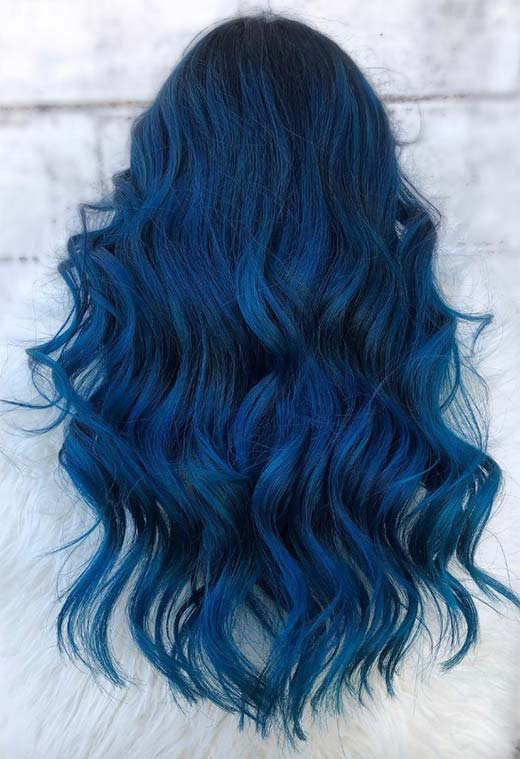
Complexion
As with most other fashion hair colors, blue hair color doesn’t look quite natural against the skin, and as a result it can bring out strange undertones or highlight imperfections. As a result, it is always a good idea to slightly increase the coverage of your foundation and ensure your skin looks as perfect as possible.
Dark hair colors often wash out the skin and draw attention away from the features, so makeup can help balance that out. The darker the shade of blue hair dye you’ve opted for, the more important it is that you keep your face sculpted with contour and highlight.
If you’re rocking a lighter blue hair color you really don’t need to worry as much and you can stick to your typical technique.
Eyes
Eye makeup is the area where we often get truly creative with color. When choosing your eyeshadow scheme don’t feel restricted to blues or neutrals – the reality is that you can make any eyeshadow color work with blue hair. You will, however, have to take into account your hair, the other colors in your makeup as well as your outfit and remember that they all come together into a color scheme.
Neon yellows and oranges can look especially striking against blue hair, while jewel-toned purples or greens will be softer and more harmonious. If the idea of doing this sounds intimidating, you can stick to nude eyeshadows, cool metallics, and smokey tones instead.
The area where you might have the biggest challenge is your eyebrows! If you’re all about that blue-haired anime character fantasy, you can certainly fill your eyebrows in with a matte blue eyeshadow that is just a shade lighter than your hair… but we think that’s a little extreme.
What we recommend instead is using a cool-toned slate or gray eyebrow product instead, as it will look more natural but without clashing or drawing attention to your blue hair.
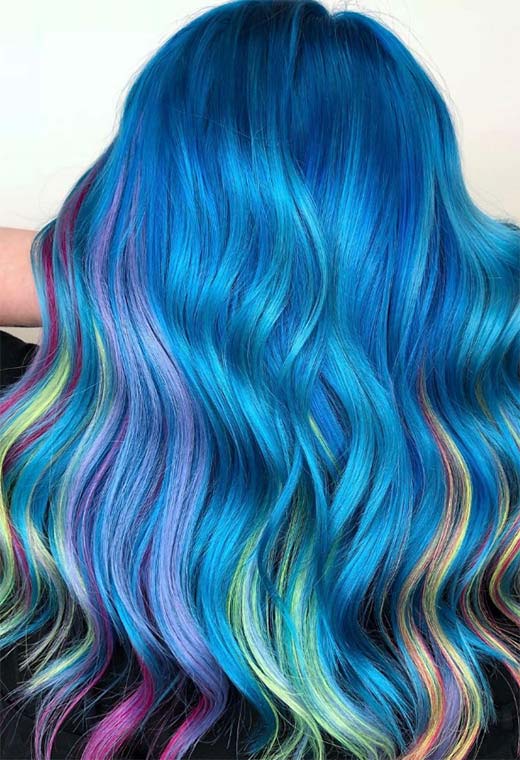
Lips and Cheeks
As long as your foundation is on point, you can actually get away with most lipstick colors while rocking blue hair. If you prefer a very harmonious, cool-toned look, you can certainly stick to lipstick and blush colors that are heavy on the blue undertones, like purples, mauves, violets, and magentas.
Blue-based red lipsticks can lend a romantic vibe to your look, especially if you occasionally curl your blue hair in a retro style. True neutral lipsticks and blushes like cool nudes, rose tones, and raspberries are also an easy choice.
Then again, if you’re brave enough to rock blue hair, do you really care about everything blending in? You can certainly opt for contrast instead! Warm blush and lipstick tones like brick red, peach, coral, and orange really stand out against blue hair in a way that is very striking and fashion-forward. It can be tricky to make these colors work if you have cool undertones to your skin, but if you’re overall warm-toned this can be quite fetching.
Fashion and Style Tips for Blue Hair
- When it doubt, black is always a safe color choice. If you’re feeling overwhelmed or if you really want your blue hair to draw all of the attention, then simply embrace the ultimate and ever-flattering neutral.
- Other neutrals like white or gray are also safe choices, as is blue denim, which will match your blue hair without it looking purposeful.
- It’s very likely that you love color, if you’ve decided to rock blue hair! If that’s the case, then have a look at the color wheel and play around with the various color blocking patterns that include blue.
- Primary colors will look especially striking against your blue hair, as will its complementary color: orange. If you’re only going to wear one color, opt for one of these.
- For a more subdued yet colorful look, opt for an analogous color scheme by pairing teal and indigo separates.
- You can also opt for a monochrome look that makes use of darker and lighter shades of blue.
- To get inspired, explore the #bluehair hashtag on Instagram and see what the influencers are wearing! Some blue-haired fashionistas that we love include @OloriSwank.
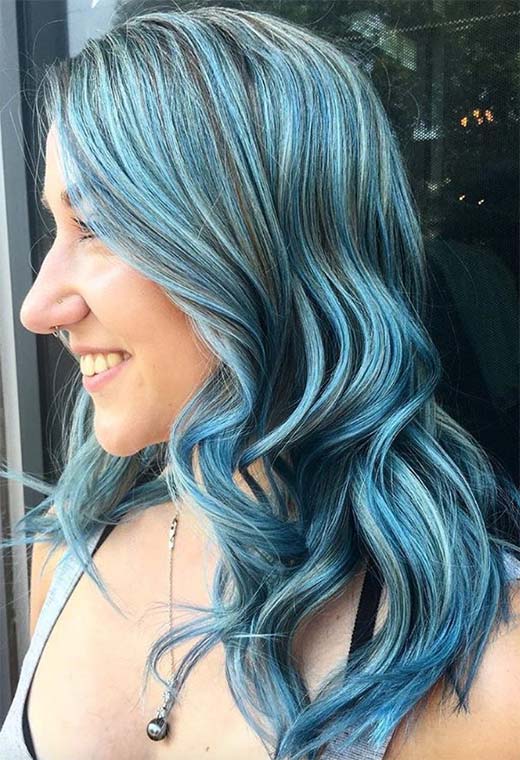
Photos via @amburgerofhair, Instagram

